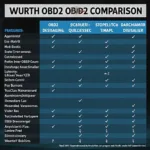Connecting your vehicle to an OBD2 WiFi scanner opens up a world of diagnostic possibilities, putting valuable data about your car’s performance right at your fingertips. This guide provides a comprehensive, step-by-step approach to connecting your car to an OBD2 WiFi scanner, empowering you to monitor and understand your vehicle’s health better.
Understanding the OBD2 WiFi Connection
OBD2, or On-Board Diagnostics II, is a standardized system that allows external electronics to communicate with a vehicle’s computer. A WiFi-enabled OBD2 scanner acts as a bridge between your car’s computer and your smartphone, tablet, or laptop, transmitting data wirelessly. This allows you to access real-time information about your engine, transmission, emissions, and more.
Locating Your OBD2 Port
The OBD2 port is typically located under the dashboard, often near the steering column or on the driver’s side. It’s a trapezoidal, 16-pin connector. If you’re having trouble locating it, consult your vehicle’s owner’s manual.
Choosing the Right OBD2 WiFi Scanner
Selecting the right scanner depends on your specific needs and budget. Consider factors such as compatibility with your vehicle’s make and model, the software features offered, and the device’s overall reliability.
Connecting to OBD2 WiFi: A Step-by-Step Guide
Here’s a detailed guide on how to connect to OBD2 WiFi:
- Plug in the OBD2 Scanner: Insert the OBD2 WiFi scanner into your vehicle’s OBD2 port. Ensure it’s securely connected.
- Turn on Your Vehicle’s Ignition: Turn the ignition key to the “on” position, but don’t start the engine. This powers up the OBD2 port and the scanner.
- Enable WiFi on Your Device: On your smartphone, tablet, or laptop, turn on WiFi.
- Connect to the Scanner’s WiFi Network: The scanner will create its own WiFi network. Find it in your device’s WiFi settings and connect to it. The network name (SSID) and password are usually printed on the scanner or in its manual. For example, you might be interested in learning about the v link obd2 wifi.
- Launch the OBD2 Software: Open the OBD2 software application on your device. Many scanners come with their own dedicated apps, or you can use third-party options.
- Start Diagnosing: Once the software connects to the scanner, you can begin accessing and interpreting your vehicle’s data.
Troubleshooting Connection Issues
If you encounter problems connecting, try these steps:
- Check the OBD2 Scanner’s Power: Verify that the scanner’s LED lights are on, indicating it’s receiving power.
- Verify WiFi Credentials: Double-check the SSID and password of the scanner’s WiFi network.
- Restart Devices: Try restarting both the scanner and your smart device.
- Check App Compatibility: Ensure the OBD2 software is compatible with your specific scanner model. Learning how to connect nissan consult with obd2 wifi can provide insights into specific compatibility challenges.
Advanced OBD2 WiFi Features
Some advanced OBD2 WiFi scanners offer features like:
- Data Logging: Record data over time to track performance trends.
- Emission Readiness Checks: Check if your vehicle is ready for emissions testing.
- Code Clearing: Clear diagnostic trouble codes (DTCs) after repairs. You might find the elm327 wifi obd2 iphone app useful for this.
“A reliable OBD2 WiFi connection empowers car owners to take control of their vehicle’s maintenance,” says automotive expert, Dr. Emily Carter. “It’s a powerful tool for understanding and addressing potential issues proactively.”
Why Use an OBD2 WiFi Scanner?
An OBD2 WiFi scanner provides a convenient and cost-effective way to monitor your car’s health, saving you time and money on potential repairs.
“Regularly using an OBD2 scanner can help detect problems early on, preventing them from escalating into major repairs,” adds Dr. Carter. “It’s an investment in the long-term health of your vehicle.” For iPhone users, the elm wifi obd2 iphone offers seamless integration.
Conclusion
Connecting to OBD2 WiFi is a straightforward process that can significantly enhance your car maintenance experience. By following this guide, you can easily access and interpret your vehicle’s data, allowing you to take proactive steps to keep your car running smoothly. Understanding how to connect to OBD2 WiFi empowers you to take control of your vehicle’s health. Are you ready to connect? You might also find our guide on car wifi hotspot obd2 informative.
FAQ
- What if my car doesn’t have an OBD2 port? Cars manufactured before 1996 in the US may not have an OBD2 port.
- Can I use any OBD2 software with any scanner? Not necessarily. Some scanners are designed to work with specific software.
- Is it safe to leave the OBD2 scanner plugged in all the time? While generally safe, it’s recommended to unplug it when not in use.
- What do the different OBD2 codes mean? OBD2 codes correspond to specific vehicle issues. You can look up their meanings online.
- Can I use an OBD2 scanner to improve my car’s performance? While some scanners offer performance monitoring features, they are primarily diagnostic tools.
- How much does an OBD2 WiFi scanner cost? Prices vary depending on features and brand, ranging from budget-friendly to high-end models.
- Where can I buy a reliable OBD2 WiFi scanner? Reputable online retailers and auto parts stores are good places to start.
Need support? Contact us via WhatsApp: +1(641)206-8880, Email: [email protected] or visit us at 789 Elm Street, San Francisco, CA 94102, USA. We have a 24/7 customer service team.
